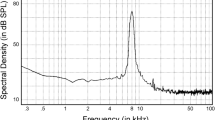Summary
Two big brown bats (Eptesicus fuscus) were trained to report the presence or absence of a virtual sonar target. The bats' sensitivity to transient masking was investigated by adding 5 ms pulses of white noise delayed from 0 to 16 ms relative to the target echo. When signal and masker occurred simultaneously, the bats required a signal energy to noise spectrum level ratio of 35 dB for 50% probability of detection. When the masker was delayed by 2 ms or more there was no significant masking and echo energy could be reduced by 30 dB for the same probability of detection. The average duration of the most energetic sonar signal of each trial was measured to be 1.7 ms and 2.4 ms for the two bats, but a simple relation between detection performance and pulse duration was not found.
In a different experiment the masking noise pulses coincided with the echo, and the duration of the masker was varied from 2 to 37.5 ms. The duration of the masker had little or no effect on the probability of detection.
The findings are consistent with an aural integration time constant of about 2 ms, which is comparable to the duration of the cries. This is an order of magnitude less than found in backward masking experiments with humans and may be an adaptation to the special constraints of echolocation. The short time of sensitivity to masking may indicate that the broad band clicks of arctiid moths produced as a countermeasure to bat predation are unlikely to function by masking the echo of the moth.
Similar content being viewed by others
Abbreviations
- SPL :
-
sound pressure level
- SD :
-
standard deviation
- SE :
-
standard error
- BW :
-
bandwidth
References
Au WWL, Moore PWB (1988) Detection of complex echoes in noise by an echolocating dolphin. J Acoust Soc Am 83:662–668
Blest AD, Collett TS, Pye JD (1963) The generation of ultrasonic signals by a New World arctiid moth. Proc R Soc Lond B 158:196–207
Boer E de (1985) Auditory time constants: A paradox? In: Michelsen A (ed) Time resolution in auditory systems. Springer, Berlin Heidelberg New York, pp 141–158
Brown CH, Maloney CG (1986) Temporal integration in two species of Old World monkeys: Blue monkeys (Cercopithecus mitis) and grey-cheeked mangabeys (Cercocebus albigena). J Acoust Soc Am 79:1058–1064
Cahlander DA, McCue JJG, Wester FA (1964) The determinations of distance by echolocating bats. Nature 201:544–546
Finney DJ (1971) Probit analysis. Cambridge University Press, London
Fullard JH, Fenton MB, Simmons JA (1979) Jamming bat echolocation: the clicks of arctiid moths. Can J Zool 57:647–649
Green DM (1985) Temporal factors in psychoacoustics. In: Michelsen A (ed) Time resolution in auditory systems. Springer, Berlin Heidelberg New York pp 122–140
Guilford JP (1954) Psychometric methods. McGraw-Hill, New York
Joermann G (1984) Recognition of spatial parameters by echolocation in the vampire bat,Desmodus rotundus. J Comp Physiol A 155:67–74
McCarthy JK, Jen PH-S (1983) Bats reject clutter interference for moving targets more successfully than for stationary ones. J Comp Physiol 152:447–454
Menne D, Hackbarth C (1986) Accuracy of distance measurement in the batEptesicus fuscus: theoretical aspects and computer simulations. J Acoust Soc Am 79:386–397
Møhl B (1986) Detection by a pipistrelle bat of normal and reversed replica of its sonar pulses. Acustica 61:75–82
Møhl B, Miller LA (1976) Ultrasonic clicks produced by the peacock butterfly: A possible bat-repellent mechanism. J Exp Biol 64:639–644
Penner MJ (1974) Effect of masker duration and masker level on forward and backward masking. J Acoust Soc Am 56:179–182
Schnitzler H-U, Henson OW Jr (1980) Performance of airborne animal sonar systems. I. Microchiroptera. In: Busnel RG, Fish JF (eds) Animal sonar systems. Plenum Press, New York, pp 109–181
Schnitzler H-U, Kalko E, Miller L, Surlykke A (1987) The echolocation and hunting behavior of the bat,Pipistrellus kuhli. J Comp Physiol A 161:267–274
Simmons JA (1971) Echolocation in bats: Signal processing of echoes for target range. Science 171:925–928
Simmons JA (1979) Perception of echo phase information in bat sonar. Science 204:1336–1338
Simmons JA (1985) Detection of sonar targets by echolocating bats. In: Escudié B, Biraud Y (eds) Proceedings of air-borne animal sonar systems. CPI, Lyon (France), pp 3.1–3.11
Simmons JA, Fenton MB, O'Farrell MJ (1978) Echolocation and pursuit of prey by bats. Science 203:16–21
Surlykke A (1988) Interaction between echolocating bats and their prey. In: Nachtigall P (ed) Animal sonar systems. Plenum Press, pp 551–566
Surlykke A, Miller LA (1985) The influence of arctiid moth clicks on bat echolocation; jamming or warning? J Comp Physiol A 156:831–843
Troest N, Møhl B (1986) The detection of phantom targets in noise by serotine bats; negative evidence for the coherent receiver. J Comp Phyisol A 159:559–567
Weber DL, Green DM (1978) Temporal factors and suppression effects in backward and forward masking. J Acoust Soc Am 64:1392–1399
Yost WA (1980) Man as mammal: psychoacoustics. In: Popper AN, Fay RR (eds) Comparative studies of hearing in vertebrates. Springer, Berlin Heidelberg New York, pp 400–420
Author information
Authors and Affiliations
Rights and permissions
About this article
Cite this article
Møhl, B., Surlykke, A. Detection of sonar signals in the presence of pulses of masking noise by the echolocating bat,Eptesicus fuscus . J. Comp. Physiol. 165, 119–124 (1989). https://doi.org/10.1007/BF00613805
Accepted:
Issue Date:
DOI: https://doi.org/10.1007/BF00613805




